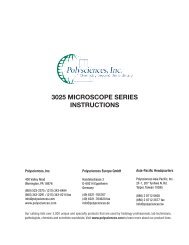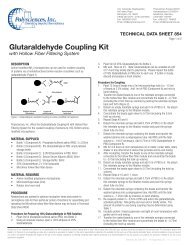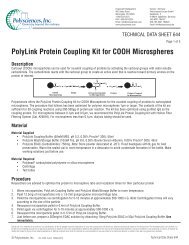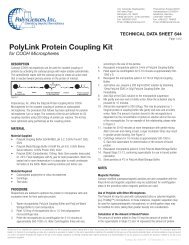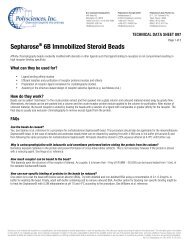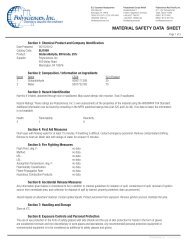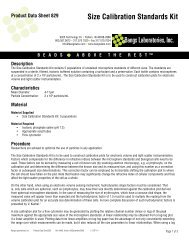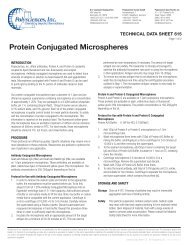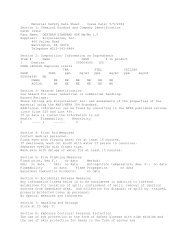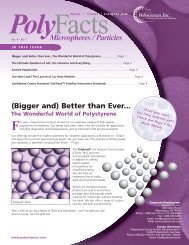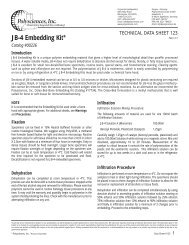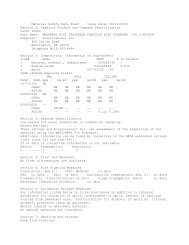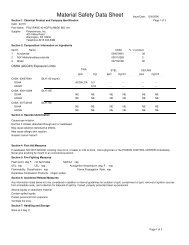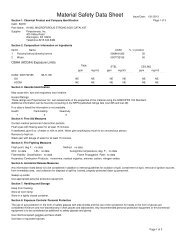BioSciences - Polysciences, Inc.
BioSciences - Polysciences, Inc.
BioSciences - Polysciences, Inc.
Create successful ePaper yourself
Turn your PDF publications into a flip-book with our unique Google optimized e-Paper software.
SHEAR STRENGTH: Key measure of adhesion for die attach<br />
adhesives and underfills. A shear strength tester pushes a die or a<br />
test part with increasing sideways force until the bond fails. Shear<br />
strength is reported in Kilograms (Kg), Kilograms Force (Kg-f), Kg/<br />
cm^2, and PSI. The total force is a function of the die size and<br />
type of substrate so it is important to always describe the parts<br />
being tested. Dage and Royce are two main suppliers of shear test<br />
equipment.<br />
SHELF LIFE: Length of time that a material may be stored and still<br />
perform per specification. Many polymers require storage at low<br />
temperature in order to be stored successfully. This temperature is<br />
typically -40°C for most polymers used as adhesive and +4°C for<br />
molding compound. Two things lead to limits in shelf life; curing<br />
of the polymer and separation (settling) of the filler.<br />
SILICA: Common name for Silicon Dioxide. Silica is the most<br />
commonly found material on earth. Silica has a very low CTE<br />
(as low as 1.5ppm), is chemically inert and in some forms can<br />
be inexpensive. It is an ideal material to use as filler for polymer<br />
materials. Silica comes in two common shapes, angular and<br />
spherical. The angular Silica is a ground up natural material (sand)<br />
and is very inexpensive. It is widely used for low cost applications<br />
such as low end molding compound. Unfortunately, because<br />
it has sharp points, it does not flow easily around obstructions<br />
(like solder bumps on a Flip Chip). It is also very abrasive and can<br />
scratch the very thin oxide on the surface of a die. Spherical Silica<br />
is fused (melted) to remove the sharp points and is preferred for<br />
advanced applications. Because the material is made using more<br />
steps it is more costly. As applications require the polymer to flow<br />
into very tight spaces (e.g., between fine pitch wires or low Flip<br />
Chip bumps) the Silica particles must be very small, typically not<br />
larger than 1/3 the narrowest gap.<br />
SILICONES: Organic compounds containing Carbon, Hydrogen,<br />
Silicon and Oxygen. Because they contain Silicon and Oxygen<br />
they are also part of the larger set of chemicals called Siloxanes.<br />
Silicones are generally stable chemicals that resist many chemicals,<br />
have good adhesion when formulated as adhesives, resist moisture<br />
and are very flexible.<br />
SILVER: Most commonly used conductive filler material. Silver<br />
is relatively inexpensive (compared to Gold), and is an excellent<br />
electrical and thermal conductor. Commonly used as flakes (tiny<br />
sheets) or kernels (rough spheres).<br />
SINGLE COMPONENT (1K): Polymer that is premixed and ready<br />
to use, requiring shipping and storage conditions below -40°C<br />
to inhibit cure. 1K is also referred to as 1 part. Some polymers<br />
require mixing two or more separate liquids just before customer<br />
use. These are dual or multi component materials commonly called<br />
2K or 2 part.<br />
Electronic Adhesives & Encapsulants<br />
SLUMP: When screen printing or dispensing a relatively thick (tall)<br />
quantity of material, the material can collapse along its edge. This<br />
collapsing is known as slump. Slump limits the practical height<br />
to which a material can be screened or dispensed. As a rule of<br />
thumb, materials cannot be printed with a height that is more<br />
than 50% of the width of the finished pattern. This is known as<br />
the Aspect Ratio. If the height is the width of a dam, the Aspect<br />
Ratio is 1 to 2.<br />
SNAP CURE: Describes die attach materials that cure in less than<br />
two minutes.<br />
SOLVENT: Material used to dissolve a solid or to reduce the<br />
viscosity of a liquid. Many commonly used semiconductor polymers<br />
are so highly viscous that they require the addition of a solvent in<br />
order to get satisfactory flow. This solvent typically must evaporate<br />
(boil off) during the curing process. If not properly managed, this<br />
can lead to voids in the cured material.<br />
SYNTHESIS: Formation of a compound from simpler compounds<br />
or elements. When organic chemicals are combined to create new<br />
properties without changing the structure of the molecules they<br />
are said to have been formulated.<br />
Tg (Glass Transition Temperature): Most materials such<br />
as metals and ceramics do not have any sudden shift in their<br />
properties over temperature. The properties may change slowly,<br />
but the change is continuous. That is not true for most polymers.<br />
Many polymer materials undergo an abrupt change in their<br />
mechanical properties at a temperature which is called the glass<br />
transition temperature. Below the glass transition temperature,<br />
polymer materials are somewhat glass like, they are stiffer and<br />
have relatively low CTE. Above the glass transition temperature,<br />
polymers are less stiff but have higher CTE. In some polymers the<br />
change in properties can be very large. For example the CTE above<br />
the Tg can be three times than below it. This makes Tg and CTE<br />
a very important contributor to stresses generated by thermal<br />
changes.<br />
THERMAL CYCLING: General term that refers to repeatedly<br />
raising and lowering the temperature of a circuit to see if it<br />
deteriorates. Cycling can be done by moving the test unit between<br />
temperature extremes slowly or rapidly. If cycling is done rapidly it<br />
is referred to 1,000,000 cps.<br />
For more information please call (800) 523-2575 or visit: www.polysciences.com 327



